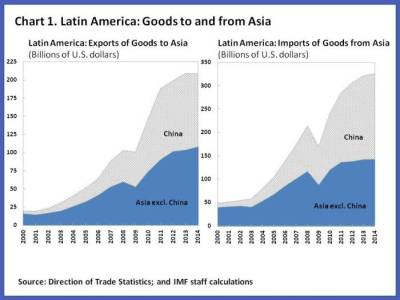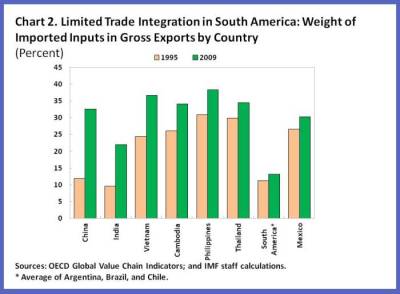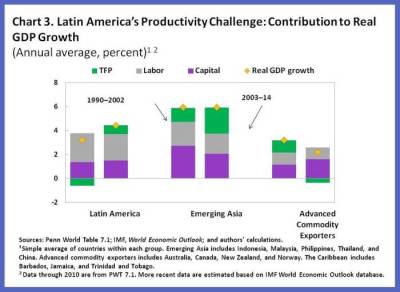(Versions in Español and Português)
Latin America’s recent economic fortunes highlight the region’s closer economic ties with Asia. China, in particular, has grown into a crucial source of demand for Latin American commodities over the past two decades, providing significant gains to the region. The flip side is that the ongoing structural slowdown of Chinese investment is weighing considerably on the prices of those commodities, and the countries that export them.
But Asia can be much more than just a source of episodic windfall gains (and losses) for Latin America. Like a windmill, Asia could help to power a stronger Latin American economy—by providing an example of successful regional trade integration and through greater direct links across the Pacific that benefit both sides. However, securing these benefits will require clear and realistic objectives, a long-term strategy, and attention to the political and social implications of greater economic integration.
Closer economic ties…
Economic relations between Latin America and Asia have strengthened significantly over the past 15 years. In particular, gross trade flows between the two regions have grown tenfold since 2000. Stronger trade linkages have also spurred a number of recent initiatives aimed at promoting further integration, including bilateral trade agreements, the Trans-Pacific Partnership, and the creation of new multilateral development banks.
The rise of China has been an important driver behind this development but it does not explain the whole story. Indeed, economic linkages have intensified with other Asian countries, too. For instance, Korea has moved up several places in the rankings of top trading partners for Brazil, Chile, and Peru since 2000. Similarly, India and Japan are important trading partners for a number of countries in Latin America.
Financial linkages have also become significant, although there is ample scope for further growth. Japanese foreign direct investment into Latin America has exceeded $110 billion between 2005 and 2014. And Chinese foreign direct investment to the region has increased sharply over the past few years—from a total of $6 billion during 1990–2009 to an average of $10 billion per year between 2010 and 2012 according to data gathered by the Economic Commission for Latin America and the Caribbean.
…amid large untapped opportunities
And yet there is great potential to deepen the economic relationship between Asia and Latin America.
In fact, the surging interregional trade has remained highly uneven. Despite some progress in growing higher-value added exports, Latin America’s shipments are still dominated by raw materials, while its imports from Asia mostly represent a broad set of manufactured goods. Although this phenomenon may partly reflect entrenched comparative advantages, it also suggests that Latin America has not been able to leverage growing trade flows to transform its own economic structures, which remain relatively undiversified. Knowledge spillovers and innovation effects that often accompany trade relations have therefore remained limited. Undiversified export baskets and limited economic complexity have also constrained the emergence of intraregional supply chains, with the notable exception of Mexico’s integration into the North American manufacturing complex.
Meanwhile, trade patterns within Asia have changed dramatically over the past 20 years. In particular, China has emerged as the linchpin of large cross-border trade (and, more recently, investment) flows, driving technology upgrading, transfer of knowhow, and the emergence of intricate global supply chains. However momentous this process, it has not played out uniformly across all of Asia (as highlighted in recent work by the Asian Development Bank). Indeed, some sub-regions have remained relatively disconnected from regional trade integration and economic dynamism. Domestic hurdles, including weak business environments, appear to be an important reason.
Realizing the potential
Similar domestic hurdles may also help to explain why Latin America has failed to develop productive complementarities and deeper intraregional trade relations of the kind observed in Asia. An array of supply-side bottlenecks, including weak education systems, infrastructure gaps, difficult business environments, and various trade barriers have constrained productivity growth, held back investment and innovation, and limited gains from closer relations with other economies. Needless to say, the boom in commodity prices between 2003 and 2011 also contributed to reinforcing a commodity-led growth model.
To address these challenges and turn trade into a sustainable engine of growth, policymakers in Latin America will need to reduce the existing obstacles to trade (including high transport costs) in the region. But a broader strategic perspective is equally critical:
- Growth reality check. Against a backdrop of lower commodity prices, tighter external financial conditions, and reduced macroeconomic policy space, achieving robust growth will be more challenging than over the previous decade. Prospects will depend on decisive efforts to address long-standing structural weaknesses that have held back investment and productivity.
- Greater trade integration can support the development of stronger Latin American economies, but objectives have to be realistic. As a number of empirical studies have documented, trade integration tends to have positive effects on productivity and knowledge transfer. But it is not a magic wand. Efforts to boost intraregional trade as well as stronger links with Asia will need to be underpinned by domestic reform agendas aimed at creating better conditions for entrepreneurial initiative, innovation, and diversification.
- Broad political backing is crucial. Despite its overall benefits, greater trade integration can have divergent effects on different groups of society. Managing these implications well and ensuring shared gains in prosperity is critical to create and sustain political support for greater openness.
In sum, Latin America can turn its relationship with Asia into a lasting source of energy and growth—like a windmill—as opposed to just an episodic source of windfall gains. Today’s weak outlook for growth, and the prospect that China’s structural investment slowdown will weigh on global commodity markets for the foreseeable future, makes it all the more crucial to start seizing this opportunity. We will explore this theme further in our next Regional Economic Outlook and in a seminar during our Annual Meetings this October in Lima, Peru.









